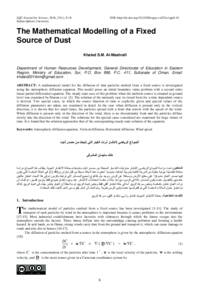Document
The mathematical modelling of a fixed source of dust.
Identifier
DOI: http://dx.doi.org/10.24200/squjs.vol23iss1pp8-18
Source
Sultan Qaboos University Journal for Science. v. 23, no. 1, p. 8-18.
Other titles
النموذج الرياضي لانتشار ذرات الغبار التي تنبعث من مصدر ثابت.
Country
Oman.
City
Muscat.
Publisher
College of Science, Sultan Qaboos University.
Gregorian
2018-05-06
Language
English
English abstract
A mathematical model for the diffusion of dust particles emitted from a fixed source is investigated using the atmospheric diffusion equation. This model poses an initial boundary value problem with a second order linear partial differential equation. The steady state case of this problem when the uniform source is situated at ground level was examined by Sharan et al. [1]. The solution of the unsteady case in closed form for a time dependent source is derived. Two special cases, in which the source function of time is explicitly given and special values of the diffusion parameters are taken, are examined in detail. In the case when diffusion is present only in the vertical direction, it is shown that for small times, the particles spread with a front that travels with the speed of the wind. When diffusion is present only in the direction of the wind, there is no discontinuity front and the particles diffuse slowly into the direction of the wind. The solutions for the special cases considered are examined for large values of time. It is found that the solution approaches that of the corresponding steady state solution of the equation.
ISSN
2414-536 X
Arabic abstract
تم دراسة نموذج رياضي لانتشار جزيئات الغبار المنبعثة من مصدر ثابت باستخدام معادلة الانتشار الجوي. يطرح هذا النموذج مشكلة قيمة حدية أولية مع معادلة تفاضلية جزئية خطية من الدرجة الثانية. تم فحص حالة الحالة المستقرة لهذه المشكلة عندما يقع المصدر الموحد على مستوى الأرض بواسطة شاران وآخرون. [1]. تم اشتقاق حل الحالة غير المستقرة في شكل مغلق لمصدر يعتمد على الوقت. يتم فحص حالتين خاصتين بالتفصيل، حيث يتم إعطاء وظيفة المصدر للوقت بشكل صريح ويتم أخذ قيم خاصة لمعلمات الانتشار. وفي حالة الانتشار في الاتجاه الرأسي فقط، فقد تبين أنه في أوقات صغيرة، تنتشر الجسيمات بجبهة تنتقل بسرعة الريح. عندما يكون الانتشار موجودًا فقط في اتجاه الريح، لا يكون هناك جبهة انقطاع وتنتشر الجسيمات ببطء في اتجاه الريح. يتم فحص حلول الحالات الخاصة التي تم النظر فيها لقيم كبيرة من الوقت. لقد وجد أن الحل يقترب من حل الحالة المستقرة المقابلة للمعادلة.
Category
Journal articles

